This article aims to provide information on What Should I Use To Clean Thermal Paste Off CPU? Although it’s not the most glamorous of jobs, maintaining a PC is necessary to make sure you’re getting the most out of it. One of those tedious jobs that takes only a few minutes is replacing the thermal interface material (TIM) on your CPU, ideally using the best thermal paste we’ve tested.
Additionally, a fresh layer of thermal paste can enhance efficiency while lowering temperatures for a longer component lifespan if your machine has been operating hot (or if the fans are continuously spinning loudly, which frequently indicates the system is toasty).
What Should I Use To Clean Thermal Paste Off CPU?
If you’re using an old CPU in a new motherboard or upgrading the cooler (maybe to one of the best CPU coolers), you’ll need to remove and replace the thermal paste on your CPU. Use the following items to clean the thermal paste Off the CPU:
- Lint-free cotton swabs
- Lint-free paper towels
- Rubbing alcohol (mostly isopropyl-based, whereas regular alcohol is ethanol-based)
- Specifically formulated cleaning wipes
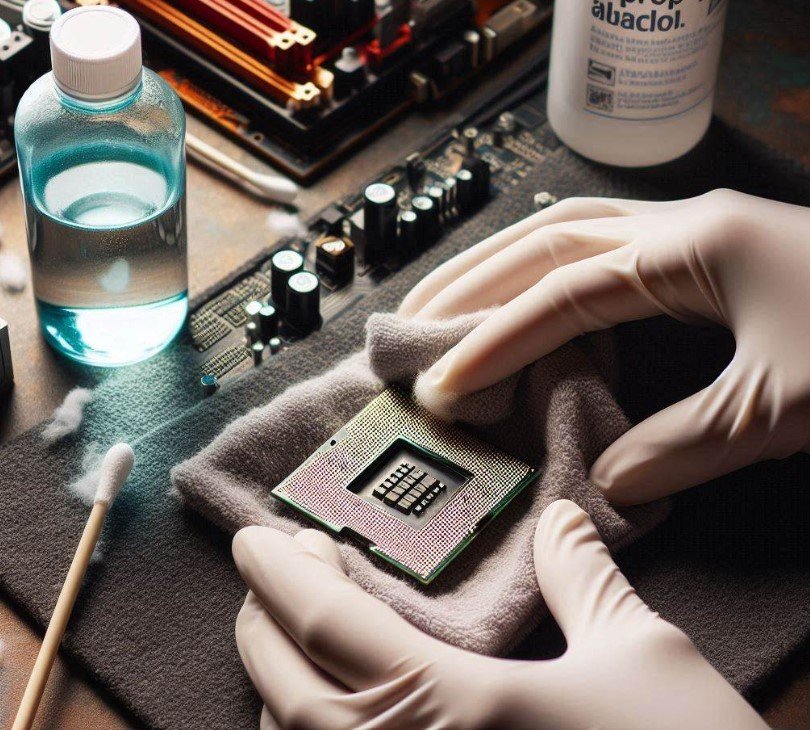
Why Do We Need To Clean Old Thermal Paste?
Some may find it common. However, some people still need to learn that you must remove old thermal paste before inserting a fresh dab. They might also need clarification about the precise cause. They’re both thermal pastes, after all. They ought to collaborate.
Not at all. As you can see, thermal paste’s useful life is limited. It gradually deteriorates and loses its effectiveness over time, usually within a year or two.
Therefore, the old thermal paste, which is no longer capable of transferring heat, would reduce the total heat transfer efficiency even if you were to layer new thermal paste on top of the old.
In essence, the main focus of the matter is the efficiency of heat transfer. Applying or reapplying thermal paste is ultimately intended to achieve effective heat transfer between your CPU’s ILH and the heatsink.
The highest level of efficiency is achieved when a single brand of thermal paste is applied consistently and all at once. Remaining in the previous one would only result in its collapse.
What To Clean Thermal Paste With?
It is not advised to clean computer components or computers with water when handling them. Rubbing alcohol is a far superior replacement for distilled water, even if it is occasionally used for intensive cleaning.
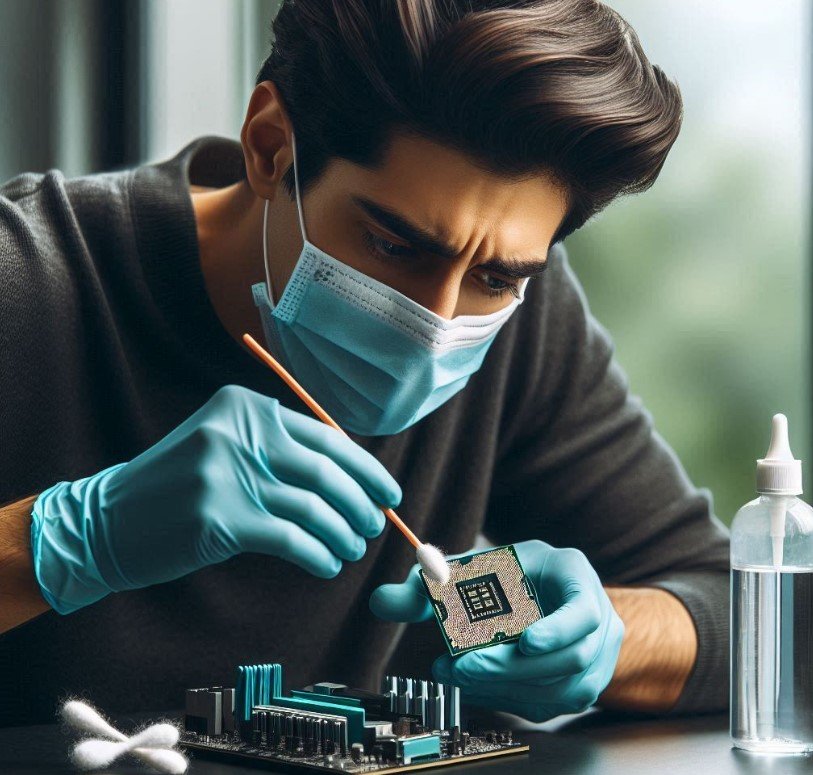
After cleaning, if there is any moisture left on your motherboard or CPU, it could cause the solder to corrode and make your parts worthless. Alcohol quickly disappears and doesn’t leave any residue.
You want something to be able to wipe off the old thermal paste in addition to rubbing alcohol. You can use a lint-free paper towel or a lint-free cotton swab in this situation.
Why is it lint-free? The accumulation of lint, or tiny bits of paper or cotton, on your motherboard or adhered to the outdated thermal paste can harm electronic parts and reduce your computer’s overall performance. Thus, there won’t be any toilet paper.
We advise utilizing specialized thermal paste cleaning wipes because of this. You won’t have to worry about splashing alcohol on your CPU or motherboard, nor will you have to make sure the scrubber leaves lint behind.
Additionally, they are pre-made with a component that is specifically developed to improve cleaning effectiveness beyond the reach of rubbing alcohol. The easiest and most effective method for removing old thermal paste from your CPU is to use thermal paste cleaning wipes.
How Do I Remove Thermal Paste From A CPU?
I clean up most of the mess using paper towels and rubbing alcohol. When everything comes to an end, a few strange lines, alcohol, and a few cotton makeup pads will do the trick.
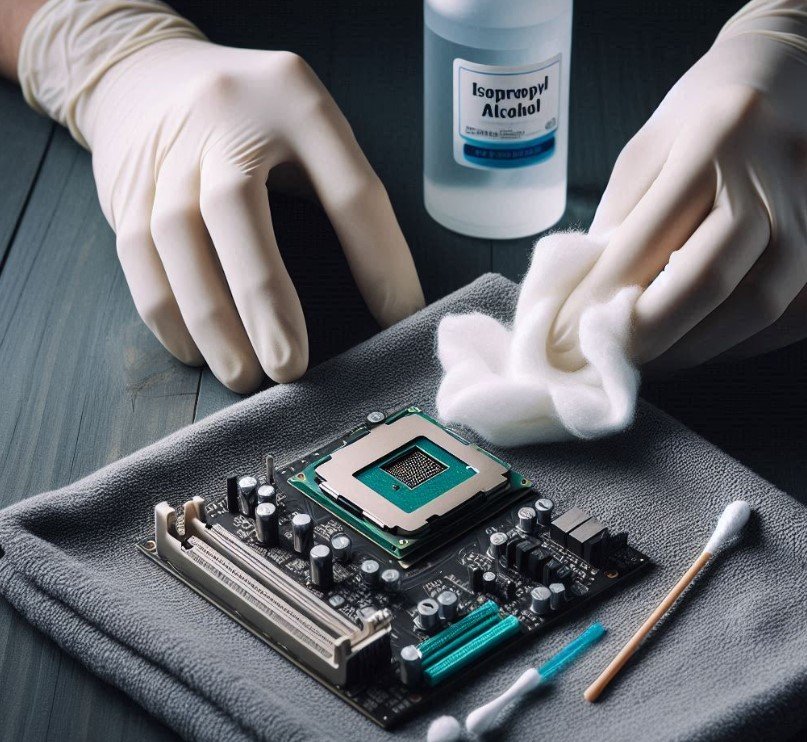
If your significant other doesn’t use makeup around the house, cotton balls can work, although occasionally they leave stray fibers behind.
How To Replace The Thermal Paste On A CPU?
- Before turning off and unplugging, please turn on the computer and let it run for a few minutes. Thermal paste has the potential to solidify, and the CPU may sustain harm if the heatsink or cooler is removed cold. You could also slightly heat the area with a hair dryer or hot air cannon.
- Take off the cooling assembly and heatsink from the CPU and GPU. To make sure that the pressure is released evenly, take your time and loosen the screws.
- To begin, use a small amount of isopropyl alcohol on a lint-free cloth to wipe the heatsink’s thermal paste. By cleaning the heatsink first, we may test how quickly the paste is removed from it before moving on to the CPU and GPU.
- Use a cloth and isopropyl alcohol to remove the paste from the CPU. After carefully removing the paste, leave the CPU in the socket. Take your time, and don’t be too strict. The recessed paste can be cleaned with a cotton swab.
- Give the CPU the recommended quantity of thermal paste. However, before applying, let the isopropyl alcohol evaporate for a while and make sure there are no liquid or debris pools.
- Replace the heatsink/cooling assembly on top of the CPU, making sure to apply equal pressure.
- To keep the heatsink and cooling assembly in place, tighten the screws in a diagonal design, a few turns at a time. This distributes the thermal paste over the top of the heat spreader/CPU while maintaining a somewhat constant pressure. Additionally, it guarantees that no corner is subjected to excessive pressure, which, in the worst situation, could physically harm your CPU.
- Switch on the computer and proceed as usual. Make sure to inspect for any misplaced cables, trapped wires, or overlooked screws before turning the power on. Minor gotchas occur more frequently than we would want to acknowledge.
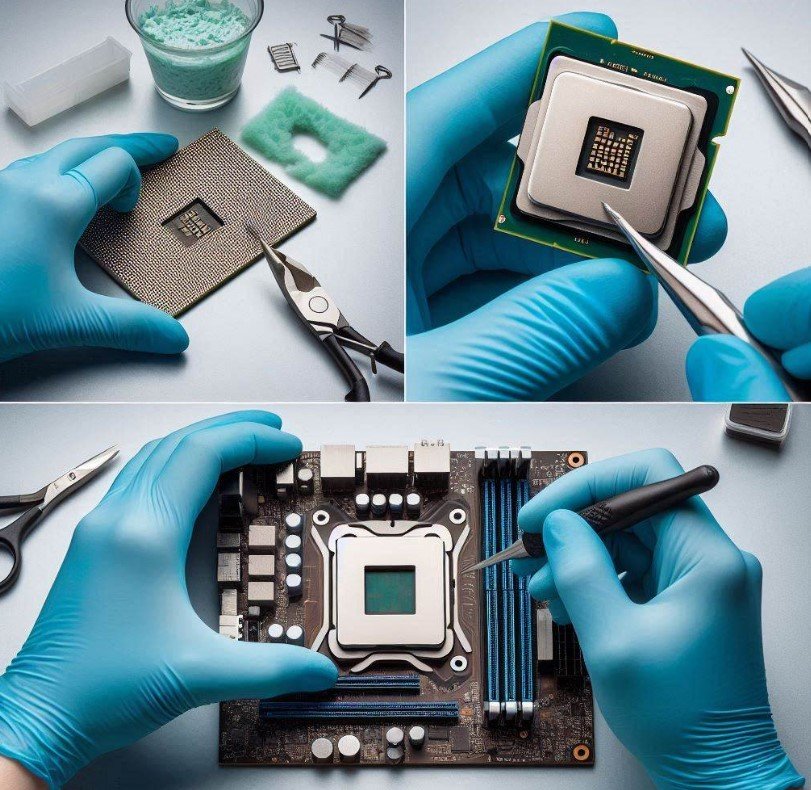
Wrong way to clean thermal paste
In addition to the best way, there is also the worst way. The worst approach is to do no cleaning at all. Keep in mind that leaving your old thermal paste on will reduce the effectiveness of heat transfer from the CPU to the heatsink.
This implies that none of the heat your CPU produces will escape the CPU, much less the casing. Over time, this will cause your computer to operate slower and may even result in unexpected shutdowns in the future! Indeed, it is that significant.
Using inferior rubbing alcohol would be the second worst (or incorrect) method. Should you decide to use rubbing alcohol, be sure to purchase it specifically for the purpose of cleaning computer hardware. Thus, it would help if you didn’t reach into your liquor cabinet to get some vodka.
We are aware of its allure. But believe us when we say that inferior alcohol might leave residue or stains on your CPU, which will also affect the effectiveness of heat transmission because the thermal paste, no matter how good, won’t be able to contact the surface of your CPU correctly.
How To Remove Thermal Paste Without Alcohol?
Although rubbing alcohol is a popular method for cleaning thermal paste, there are a few more approaches that can yield comparable outcomes:
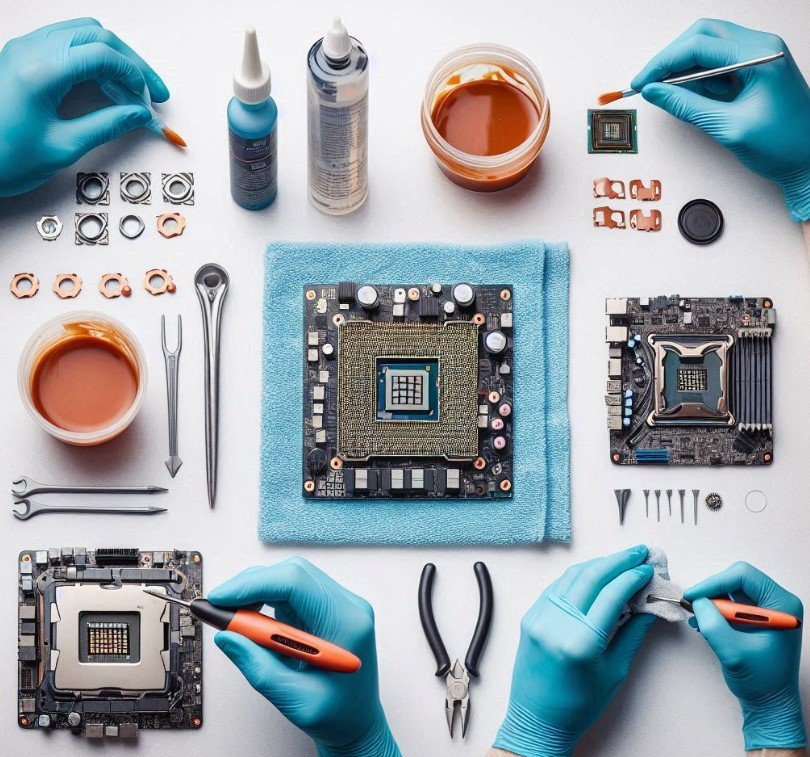
Microfiber or lint-free cloth
An easy technique to get rid of thermal paste is to use a microfiber or lint-free cloth. First, turn off your computer and remove the CPU cooler.
Using the fabric, carefully remove any remaining thermal paste residue, being cautious not to push too hard. Continue doing this until the surface is clean. Although this approach could be more work than drinking, it works well and is readily available.
Coffee filters
Another everyday household object that can be used to get rid of thermal paste is coffee filters. Switch off your computer and remove the CPU cooler, just like with the cloth approach.
Gently wipe the CPU surface of the thermal paste residue with a clean coffee filter. The coffee filter’s texture aids in lifting the paste without shedding fibers or lint. Continue as needed until the surface is spotless.
Use cotton swabs or Q-tips
To remove thermal paste, use cotton swabs or Q-tips along with a moderate solvent like water or vinegar. Make sure the swab does not drip when you dampen it with a little water or vinegar, then gently remove the thermal paste residue.
Take care not to oversaturate the swab since too much liquid can harm the parts. Repeat until the surface is clean, then let it completely dry before applying another layer of thermal paste.
Tool for scraping
A plastic scraping tool can be used to carefully remove any remaining thermal paste residue without damaging the CPU surface. Use caution when applying this technique to prevent gouging or scraping the surface.
After scraping off the majority of the paste, use one of the previously stated cleaning techniques to get rid of any leftover residue.
Warm water and mild soap
When rubbing alcohol is not available, use warm water and mild soap to remove the residue. Mix a tiny bit of dish soap with warm water to make a solution.
Wipe up any remaining thermal paste residue by gently dampening a cloth or cotton swab with the solution. Make sure the surface is totally dry before reapplying the thermal paste and reinstalling the CPU cooler.
With the correct equipment and methods, thermal paste removal without the use of alcohol is entirely possible. The most important thing is to be thorough but gentle when using a scraping tool, cotton swabs, coffee filters, or lint-free fabric.
Maintaining the thermal interface on your CPU assures peak performance and extends the life of your hardware.
The techniques in this article may help you successfully clean your CPU without using alcohol, which will also help you maintain a stable system for many years to come.
Further considerations for removing thermal paste without alcohol:
Commercial thermal paste removers
There are commercial thermal paste removers on the market, but rubbing alcohol is more popular. These products are designed to dissolve thermal paste residue efficiently.
Some might have solvents with citrus bases or other non-alcoholic components. When using these items, make sure to carefully follow the manufacturer’s directions to guarantee the safe and efficient removal of thermal paste.
Compressed air
It’s best to use compressed air to clear away any loose dust or debris surrounding the CPU area before attempting to remove the thermal paste.
This ensures a cleaner surface by keeping impurities from blending with the thermal paste during cleanup. Use brief air bursts to prevent injuring delicate components.
Patience and thoroughness
When removing thermal paste without alcohol, patience, and thoroughness are crucial, regardless of the technique selected. Make sure all residue is entirely gone by taking your time and gently cleaning the CPU’s surface and surrounding locations.
A thorough cleaning process helps guarantee appropriate heat transfer and guards against future performance problems or overheating.
Preventative maintenance
You can lessen the frequency of thermal paste removal by performing routine maintenance on your CPU and cooling system.
Dust off parts of your system regularly and make sure there’s enough airflow. Additionally, to reduce extra paste and facilitate removal in the future, thermal paste should be applied using the pea-sized or rice-grain method.
Safety measures
It’s essential to follow safety procedures when handling electronic components to prevent harm or damage. Always turn off your computer and unplug it from the wall before doing any repair on it.
Take caution when handling components to prevent static discharge or bodily harm. If you’re using liquid-based cleaning techniques, make sure the parts are totally dry before reassembling them to avoid short circuits.
Although rubbing alcohol is a popular solvent for thermal paste removal, there are a few other techniques that can provide comparable outcomes.
The removal of thermal paste residue from CPU surfaces can be accomplished with a variety of everyday home objects and methods, such as lint-free cloths, coffee filters, cotton swabs, scraping tools, and mildly soapy water.
Alcohol-based solvents are not necessary if you maintain optimal thermal performance and extend the lifespan of your gear with diligence, patience, and appropriate safety precautions.
Preventive care and routine maintenance also help your computer system last longer and be in better overall condition.
How Often Should You Apply Heat Paste?
This is up to you; some people update their heat paste annually, while others leave it in place for years at a time with little problem. Intel says to apply the solution again every few years or whenever you take your cooler off for any reason.

Your thermal paste should last you for quite some time, but watch your temperatures; if they begin to climb, it may indicate that the paste is drying out.
Conclusion
Thermal paste transfers heat from the CPU to the heatsink to keep your computer from overheating. To keep your computer in good working order, you must replace this paste regularly because it might dry out with time.
Before handling any of your computer’s internal components, be sure you take the necessary precautions against electrostatic discharge.
People Also Ask
Why is it so important to clean off old thermal paste before using new?
It’s essential to remove old thermal paste since it deteriorates with time and loses its capacity to transfer heat efficiently. The objective of thermal paste is undermined when the new paste is layered on top of the old, deteriorated paste, reducing total heat transfer efficiency.
Which substances are safe to use to remove thermal paste from a CPU?
There are safe things to use to remove thermal paste from a CPU, such as lint-free cotton swabs, lint-free paper towels, isopropyl-based rubbing alcohol, and thermal paste cleaning tools. These cleaning agents are efficient and do not damage electronic components or leave behind residues.
Why shouldn’t I remove the thermal paste with water or cheap alcohol?
It is not advised to use water to remove thermal paste since it may leave behind moisture that could lead to corrosion or harm to electronic parts. Poor-quality alcohol can leave stains or other contaminants on your CPU, which would reduce the effectiveness of the new thermal paste’s heat transfer.






